Global Connected Aircraft Market Forecast
- The connected aircraft market size to reach US$20.6 Bn in 2030, up from US$9.8 Bn attained in 2022
- Market valuation projected to witness an impressive CAGR of 11.2% during 2023 - 2030
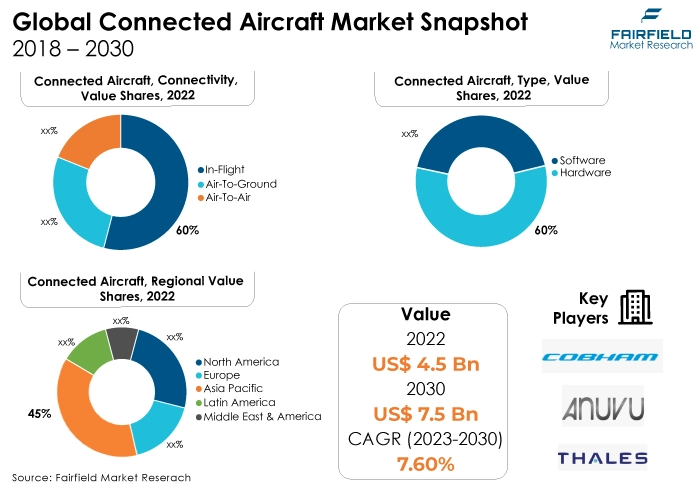
Quick Report Digest
- The key trend anticipated to fuel the connected aircraft market growth is an increase in the demand for real-time data analytics and enhanced passenger experience.
- Another major market trend expected to fuel the Advancements in satellite communication technology.
- The industry is expanding as a result of the increased focus on digitisation and the requirement for real-time data sharing between aircraft and ground systems.
- In 2022, commercial aviation, due to widespread adoption by airlines. The major causes of this dominance are the large volume of passengers, the rising need for in-flight internet, and the necessity for airlines to stay ahead of the technology curve.
- The dominance of hardware, including sensors and communication devices, in the connected aircraft market due to hardware components are the backbone of any connected system.
- In 2022, in-flight connectivity, providing seamless internet access to passengers, is a dominant category in the connected aircraft market due to the growing demand for enhanced passenger experience and the increasing reliance on digital devices.
- Asia Pacific dominates due to the expanding aviation sector in countries like China, and India. Rapid technological adoption and government initiatives drive the connected aircraft market.
- North America experiences significant growth due to extensive research and development activities. The presence of key market players and increasing investments fuel the market growth.
A Look Back and a Look Forward - Comparative Analysis
The connected aircraft industry is experiencing rapid growth driven by increasing demand for in-flight connectivity, enhanced passenger experience, operational efficiency, and safety improvements. Airlines are investing significantly in upgrading their fleets with advanced communication systems, including satellite-based internet connectivity and in-flight entertainment services. The growing emphasis on digitalisation and the need for real-time data exchange between aircraft and ground systems are further propelling the market forward.
The market witnessed staggered growth during the historical period 2018 – 2022. there has been a steady evolution in aviation communication and connectivity solutions. The period witnessed a surge in the adoption of satellite-based communication systems, enabling seamless connectivity even in remote regions. Airlines embraced these technologies to meet the demands of tech-savvy passengers, leading to substantial growth in the in-flight connectivity market.
The connected aircraft market is poised for significant expansion. With the continued digital transformation of the aviation industry, there will be a heightened focus on predictive maintenance, data analytics, and IoT-based solutions. AI and ML algorithms will play a crucial role in optimising flight operations, reducing downtime, and enhancing overall efficiency. Moreover, the proliferation of 5G technology will revolutionise in-flight connectivity, offering unprecedented internet speeds and enabling advanced entertainment options for passengers.
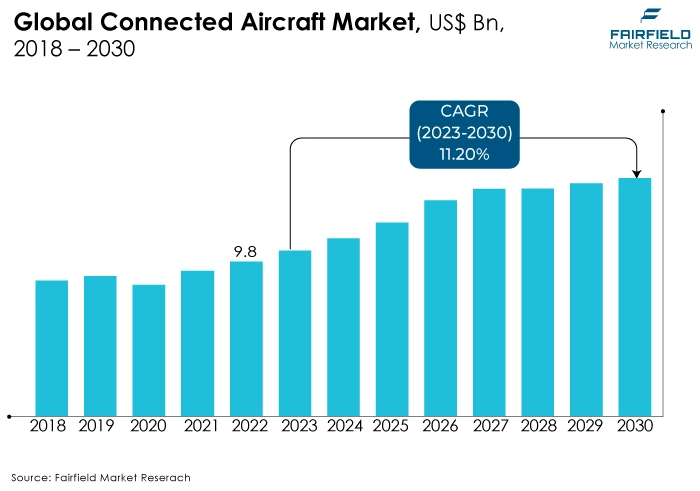
Key Growth Factors
- In-Flight Connectivity Revolution
In-flight connectivity stands as a primary market driver, revolutionising air travel by providing seamless internet access to passengers. As the demand for staying digitally connected during flights soars, airlines are investing in advanced satellite communication systems. This driver is fueled by the growing expectation of passengers to have reliable internet access for work, entertainment, and communication during flights.
The aviation industry is witnessing a shift from traditional air-to-ground systems to advanced satellite-based technologies, enhancing the overall passenger experience and contributing significantly to the connected aircraft market's growth.
- Operational Efficiency and Predictive Maintenance
Operational efficiency is a critical driver in the connected aircraft market. Airlines are adopting connected technologies to optimise flight operations, streamline maintenance processes, and improve overall efficiency. Predictive maintenance, enabled by IoT sensors and real-time data analytics, allows airlines to anticipate component failures before they occur.
By reducing downtime and minimising unscheduled maintenance, airlines can ensure higher aircraft availability and operational reliability. This operational streamlining not only enhances safety but also translates into substantial cost savings, driving the widespread adoption of connected aircraft technologies.
- Enhanced Safety and Situational Awareness
Connected aircraft solutions significantly enhance safety and situational awareness for both pilots and ground control. Real-time data streaming from various aircraft systems enables predictive analytics, helping pilots anticipate and mitigate potential risks.
Weather updates, airspace congestion information, and live aircraft health monitoring are accessible in real-time, ensuring informed decision-making during flights. Additionally, these technologies facilitate seamless communication between aircraft and ground control, enabling quicker responses to emergencies and improving overall flight safety standards.
Major Restraints
- Regulatory Challenges and Compliance Burden
The connected aircraft market revolves around stringent regulatory requirements. Implementing advanced connectivity solutions often involves navigating complex regulations imposed by aviation authorities worldwide. Ensuring compliance with diverse standards and protocols becomes a significant challenge for aviation companies. Meeting these regulatory demands can slow down the implementation of connected technologies, impeding the market's rapid growth.
- Cybersecurity Concerns, and Data Vulnerability
Cybersecurity emerges as a significant market restraint due to the sensitive nature of data transmitted and stored in connected aircraft systems. As aviation networks become more interconnected, the risk of cyber-attacks and data breaches rises. Ensuring robust cybersecurity measures becomes imperative to safeguard critical flight data, passenger information, and operational details.
Addressing these concerns requires substantial investment in cybersecurity technologies and protocols, posing a challenge for companies aiming to balance technological advancements with data security and integrity.
Key Trends and Opportunities to Look at
- In-Flight Entertainment Evolution
The connected aircraft market witnessed a surge in innovative in-flight entertainment systems. Advanced streaming services, VR experiences, and interactive content have gained popularity globally. Key players like Panasonic Avionics, and Thales Group lead the way, continuously enhancing passenger experiences. Airlines leverage these trends to offer personalised entertainment, enhancing customer satisfaction and loyalty.
- IoT Integration, and Predictive Maintenance
IoT integration in aircraft leads to predictive maintenance, minimising downtime and reducing operational costs. Companies like Boeing and Airbus invest heavily in IoT technologies. Predictive maintenance becomes a standard practice, ensuring airlines operate efficiently. Brands leverage this trend to offer airlines comprehensive solutions, ensuring optimal aircraft performance, safety, and cost-effectiveness.
- Enhanced Passenger Connectivity
Passenger demand for seamless connectivity drives the market. Satellite-based internet services from providers like Viasat and Inmarsat become ubiquitous. Airlines, especially in North America and Europe, prioritise high-speed Wi-Fi installations. Key developments include advancements in satellite technology, enabling global connectivity. Brands focus on leveraging this trend by offering reliable, high-speed internet services, catering to the connected lifestyles of modern travelers.
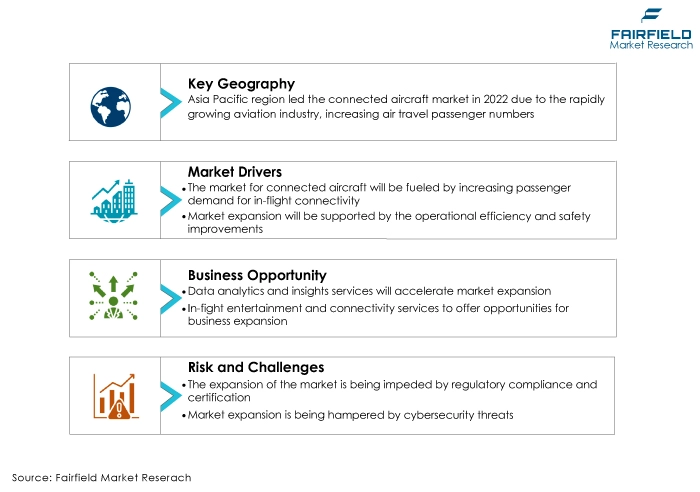
How Does the Regulatory Scenario Shape this Industry?
The connected aircraft market operates within a stringent global regulatory framework governed by aviation authorities such as the Federal Aviation Administration (FAA) in the United States and the European Union Aviation Safety Agency (EASA) in Europe. These entities establish crucial standards and guidelines, ensuring the safety, security, and reliability of aircraft communication systems.
Compliance with industry-defined safety levels, including standards like DO-178C and DO-254 for software and hardware development, is mandatory. Region-specific regulations, such as those set by China's Civil Aviation Administration of China (CAAC) in the Asia-Pacific region, further shape the industry. Adherence to citations from regulatory documents, industry reports like those from the International Air Transport Association (IATA), and research papers ensures connected aircraft technologies align with established protocols, enabling their seamless integration into the aviation ecosystem.
Fairfield’s Ranking Board
Top Segments
- Hardware Category Continues to Dominate over Software Segments
The hardware segment, encompassing sensors and communication devices in 2022, approximately accounting for 60% of the total connected aircraft market, stands as the dominant force in the connected aircraft market. Hardware forms the backbone of connected aviation systems, including crucial components like sensors, routers, and communication devices. The demand for these tangible technologies is exceptionally high due to their role in ensuring the seamless flow of data between various systems within an aircraft.
Furthermore, the software segment is the fastest-growing category in the connected aircraft market, growing at a rate of 12% annually. As technology continues to advance, the significance of software solutions, particularly in terms of data analytics, predictive maintenance, and cybersecurity, is rapidly increasing. Airlines and aviation service providers are adopting advanced software applications to optimise flight operations, analyse big data for better decision-making, and enhance passenger services.
- Commercial Aviation Sector Surges Ahead
In 2022, the commercial aviation sector has firmly established itself as the dominant force in the connected aircraft market. With approximately 70% of the market share, commercial aviation companies have been the primary adopters of connected technologies. This dominance is primarily due to the high passenger traffic, increasing demand for in-flight connectivity, and the imperative for airlines to remain technologically competitive.
The UAV represents the fastest-growing category in the connected aircraft market, with an annual growth rate of 15%; the UAV segment is experiencing rapid expansion, driven by military applications, surveillance needs, and emerging applications in industries like agriculture, environmental monitoring, and disaster management. The demand for connected systems in UAVs is surging due to the need for real-time data transmission and analysis.
- In-Flight Connectivity Contributes the Maximum Share
In-flight connectivity stands as the dominant category in the connected aircraft market, commanding nearly 60% of the market share. This dominance is attributed to the escalating demand for seamless internet access during flights, driven by the growing expectations of passengers for connectivity akin to what they experience on the ground.
Air-to-ground (ATG) Connectivity emerges as the fastest-growing category in the connected aircraft market, with an impressive annual growth rate of 25%. This growth is fueled by the need for consistent, high-speed internet connectivity, especially over landmasses. ATG systems utilise ground-based stations to provide internet services to aircraft, ensuring stable connections even during flights over terrestrial areas.
Regional Outlook
Asia Pacific Responsible for 40% of Global Market Revenue
Asia Pacific continues to be the largest revenue-contributing region in the global connected aircraft market, commanding a substantial market share of approximately 40%. This leadership position can be attributed to several factors. The region is home to some of the world's fastest-growing economies, leading to increased air travel and subsequent demand for advanced in-flight connectivity services. The booming aviation sector in countries like China, and India has led to significant investments in modernising aircraft fleets, including integrating advanced connectivity solutions. Additionally, the rising middle-class population in many Asia Pacific countries has resulted in higher disposable incomes, enabling more passengers to afford and demand premium in-flight connectivity services.
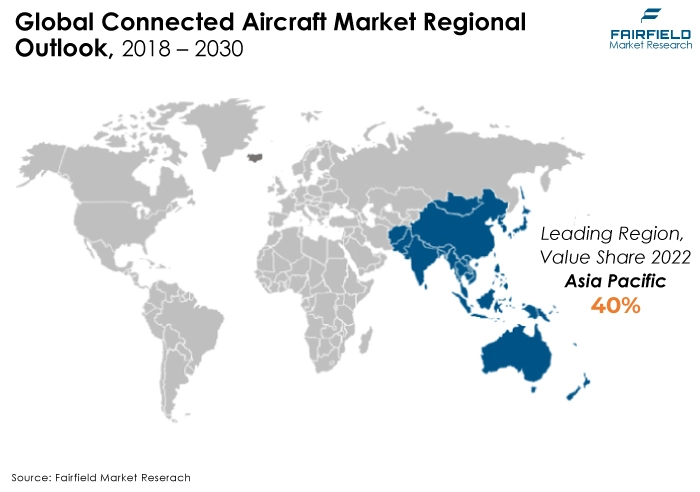
North America Emerges Highly Lucrative on the Back of Consistently Growing Demand for Cutting-edge In-Flight Connectivity Services
North America is poised to experience substantial growth in sales during the forecast period, capturing an estimated market share of around 35% in the global connected aircraft market. North America is home to some of the world's leading aviation companies and technology innovators, fostering a conducive environment for the development and adoption of advanced connected aircraft solutions.
The region has a highly developed aviation infrastructure, and a large number of commercial airlines, driving the continuous demand for cutting-edge in-flight connectivity services. Additionally, the presence of major airlines and defence organisations, coupled with ongoing advancements in military aviation technologies, further propels the demand for connected aircraft solutions in North America.
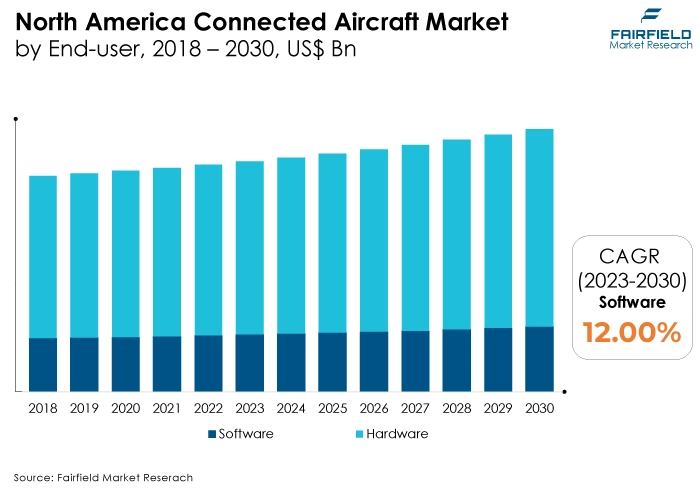
Fairfield’s Competitive Landscape Analysis
In the competitive landscape, innovation and differentiation will be key drivers. Companies offering unique, customizable, and scalable solutions are likely to gain a competitive edge. The focus will shift toward developing smart, predictive maintenance systems that reduce downtime and enhance operational efficiency. Moreover, integrating artificial intelligence and machine learning algorithms into connected aircraft systems will enable proactive issue resolution and improve overall performance.
Who are the Leaders in Global Connected Aircraft Space?
- Anuvu
- Cobham Plc
- Thales Group
- GOGO LLC
- Panasonic Avionics Company
- Honeywell International Inc.
- BAE Systems PLC
- Collins Aerospace
- Kontron
- ViaSat Inc.
- Inmarsat Global Limited
- Raytheon Inc
- Eagle Entertainment Inc
- Delta Air Lines
- FlyExclusive
Significant Company Developments
New Product Launch
- May 2023: FlyExclusive chose Gogo Inc.'s popular AVANCE platform to upgrade 40 of their private aircraft. The decision was taken to benefit from Gogo's acclaimed connectivity and customer service, enhancing the overall experience for their passengers.
- Jan 2021: Delta Air Lines has chosen Viasat's cutting-edge Ka-band satellite in-flight connectivity (IFC) solution for over 300 mainline narrow-body aircraft. This includes new deliveries as well as retrofits on A321ceo, 737-900ER, and select 757-200 aircraft.
- March 2020: Gogo Business Aviation's AVANCE Systems has successfully completed one million flights since its introduction in August 2017. The company aims to build strong alliances with major airlines worldwide to offer in-flight connectivity services in the coming years.
Distribution Agreement
- June 2023: Honeywell announced the signing of a Memorandum of Understanding (MOU) with ST Engineering. The collaboration aims to explore potential opportunities in retrofit, modification, and upgrade (RMU) programs for both fixed-wing and rotary-wing aircraft platforms.
- February 2023: GE's subsidiary in India announced that it had signed a contract with Cochin Shipyard to provide a digital solutions package to increase the capabilities of the LM2500 marine gas turbines that will power the Indian Navy's first Indigenous Aircraft Carrier-1 (IAC-1) Vikrant, which was commissioned in August 2022.
From the Analyst's Perspective
Demand and Future Growth
The future of the connected aircraft market is promising, primarily driven by the rising demand for advanced in-flight entertainment and connectivity services. With passengers increasingly expecting seamless Wi-Fi, streaming capabilities, and real-time data access during flights, the market for connected aircraft is poised for significant growth. Moreover, the aviation industry's focus on enhancing passenger experience and operational efficiency will further fuel the demand for innovative connected solutions.
Supply Side of the Market
According to our analysis, the connected aircraft market faces challenges related to the complexity of integrating various technologies into existing aircraft systems. Aircraft manufacturers need to develop solutions that seamlessly integrate with different aircraft models and meet industry standards and regulations. Additionally, ensuring the availability of skilled professionals to install, maintain, and upgrade these systems poses another challenge. The market dynamics also highlight the importance of partnerships between airlines, technology providers, and regulatory bodies.
Collaboration in research and development efforts, sharing best practices, and fostering standardisation will be essential to overcome these challenges and ensure a streamlined supply chain. Furthermore, the rapid advancements in technology necessitate continuous training and upskilling of professionals to keep up with the latest trends and innovations. This will help ensure that the industry remains competitive and capable of meeting evolving customer demands. Additionally, effective communication and coordination among all stakeholders involved in the supply chain will be crucial to minimise disruptions and maximise efficiency.
Global Connected Aircraft Market is Segmented as Below:
By Type :
- Hardware
- Software
By Platform:
- Commercial
- Business & General Aviation
- Military
- UAV
- AAM
By Connectivity:
- In-Flight
- Air-To-Air
- Air-To-Ground
By Geographic Coverage:
- North America
- U.S.
- Canada
- Europe
- Germany
- U.K.
- France
- Italy
- Turkey
- Russia
- Rest of Europe
- Asia Pacific
- China
- Japan
- South Korea
- India
- Southeast Asia
- Rest of Asia Pacific
- Latin America
- Brazil
- Mexico
- Argentina
- Rest of Latin America
- Middle East & Africa
- GCC
- South Africa
- Egypt
- Nigeria
- Rest of the Middle East & Africa
1. Executive Summary
1.1. Global Connected Aircraft Market Snapshot
1.2. Future Projections
1.3. Key Market Trends
1.4. Regional Snapshot, by Value, 2022
1.5. Analyst Recommendations
2. Market Overview
2.1. Market Definitions and Segmentations
2.2. Market Dynamics
2.2.1. Drivers
2.2.2. Restraints
2.2.3. Market Opportunities
2.3. Value Chain Analysis
2.4. Porter’s Five Forces Analysis
2.5. Covid-19 Impact Analysis
2.5.1. Supply
2.5.2. Demand
2.6. Impact of Ukraine-Russia Conflict
2.7. Economic Overview
2.7.1. World Economic Projections
2.8. PESTLE Analysis
3. Global Connected Aircraft Market Outlook, 2018 - 2030
3.1. Global Connected Aircraft Market Outlook, by Type,Value (US$ Bn), 2018 - 2030
3.1.1. Key Highlights
3.1.1.1. Hardware
3.1.1.2. Software
3.2. Global Connected Aircraft Market Outlook, by Platform, Value (US$ Bn), 2018 - 2030
3.2.1. Key Highlights
3.2.1.1. Commercial
3.2.1.2. Business & General Aviation
3.2.1.3. Military
3.2.1.4. UAV
3.2.1.5. AAM
3.3. Global Connected Aircraft Market Outlook, by Connectivity, Value (US$ Bn), 2018 - 2030
3.3.1. Key Highlights
3.3.1.1. In-Flight
3.3.1.2. Air-To-Air
3.3.1.3. Air-To-Ground
3.4. Global Connected Aircraft Market Outlook, by Region, Value (US$ Bn), 2018 - 2030
3.4.1. Key Highlights
3.4.1.1. North America
3.4.1.2. Europe
3.4.1.3. Asia Pacific
3.4.1.4. Latin America
3.4.1.5. Middle East & Africa
4. North America Connected Aircraft Market Outlook, 2018 - 2030
4.1. North America Connected Aircraft Market Outlook, by Type, Value (US$ Bn), 2018 - 2030
4.1.1. Key Highlights
4.1.1.1. Hardware
4.1.1.2. Software
4.2. North America Connected Aircraft Market Outlook, by Platform, Value (US$ Bn), 2018 - 2030
4.2.1. Key Highlights
4.2.1.1. Commercial
4.2.1.2. Business & General Aviation
4.2.1.3. Military
4.2.1.4. UAV
4.2.1.5. AAM
4.3. North America Connected Aircraft Market Outlook, by Connectivity, Value (US$ Bn), 2018 - 2030
4.3.1. Key Highlights
4.3.1.1. In-Flight
4.3.1.2. Air-To-Air
4.3.1.3. Air-To-Ground
4.3.2. BPS Analysis/Market Attractiveness Analysis
4.4. North America Connected Aircraft Market Outlook, by Country, Value (US$ Bn), 2018 - 2030
4.4.1. Key Highlights
4.4.1.1. U.S. Connected Aircraft Market by Type, Value (US$ Bn), 2018 - 2030
4.4.1.2. U.S. Connected Aircraft Market, by Platform, Value (US$ Bn), 2018 - 2030
4.4.1.3. U.S. Connected Aircraft Market, by Connectivity, Value (US$ Bn), 2018 - 2030
4.4.1.4. Canada Connected Aircraft Market by Type, Value (US$ Bn), 2018 - 2030
4.4.1.5. Canada Connected Aircraft Market, by Platform, Value (US$ Bn), 2018 - 2030
4.4.1.6. Canada Connected Aircraft Market, by Connectivity, Value (US$ Bn), 2018 - 2030
4.4.2. BPS Analysis/Market Attractiveness Analysis
5. Europe Connected Aircraft Market Outlook, 2018 - 2030
5.1. Europe Connected Aircraft Market Outlook, by Type, Value (US$ Bn), 2018 - 2030
5.1.1. Key Highlights
5.1.1.1. Hardware
5.1.1.2. Software
5.2. Europe Connected Aircraft Market Outlook, by Platform, Value (US$ Bn), 2018 - 2030
5.2.1. Key Highlights
5.2.1.1. Commercial
5.2.1.2. Business & General Aviation
5.2.1.3. Military
5.2.1.4. UAV
5.2.1.5. AAM
5.3. Europe Connected Aircraft Market Outlook, by Connectivity, Value (US$ Bn), 2018 - 2030
5.3.1. Key Highlights
5.3.1.1. In-Flight
5.3.1.2. Air-To-Air
5.3.1.3. Air-To-Ground
5.3.2. BPS Analysis/Market Attractiveness Analysis
5.4. Europe Connected Aircraft Market Outlook, by Country, Value (US$ Bn), 2018 - 2030
5.4.1. Key Highlights
5.4.1.1. Germany Connected Aircraft Market by Type, Value (US$ Bn), 2018 - 2030
5.4.1.2. Germany Connected Aircraft Market, by Platform, Value (US$ Bn), 2018 - 2030
5.4.1.3. Germany Connected Aircraft Market, by Connectivity, Value (US$ Bn), 2018 - 2030
5.4.1.4. U.K. Connected Aircraft Market by Type, Value (US$ Bn), 2018 - 2030
5.4.1.5. U.K. Connected Aircraft Market, by Platform, Value (US$ Bn), 2018 - 2030
5.4.1.6. U.K .Connected Aircraft Market, by Connectivity, Value (US$ Bn), 2018 - 2030
5.4.1.7. France Connected Aircraft Market by Type, Value (US$ Bn), 2018 - 2030
5.4.1.8. France Connected Aircraft Market, by Platform, Value (US$ Bn), 2018 - 2030
5.4.1.9. France Connected Aircraft Market, by Connectivity, Value (US$ Bn), 2018 - 2030
5.4.1.10. Italy Connected Aircraft Market by Type, Value (US$ Bn), 2018 - 2030
5.4.1.11. Italy Connected Aircraft Market, by Platform, Value (US$ Bn), 2018 - 2030
5.4.1.12. Italy Connected Aircraft Market, by Connectivity, Value (US$ Bn), 2018 - 2030
5.4.1.13. Turkey Connected Aircraft Market by Type, Value (US$ Bn), 2018 - 2030
5.4.1.14. Turkey Connected Aircraft Market, by Platform, Value (US$ Bn), 2018 - 2030
5.4.1.15. Turkey Connected Aircraft Market, by Connectivity, Value (US$ Bn), 2018 - 2030
5.4.1.16. Russia Connected Aircraft Market by Type, Value (US$ Bn), 2018 - 2030
5.4.1.17. Russia Connected Aircraft Market, by Platform, Value (US$ Bn), 2018 - 2030
5.4.1.18. Russia Connected Aircraft Market, by Connectivity, Value (US$ Bn), 2018 - 2030
5.4.1.19. Rest of Europe Connected Aircraft Market by Type, Value (US$ Bn), 2018 - 2030
5.4.1.20. Rest of Europe Connected Aircraft Market, by Platform, Value (US$ Bn), 2018 - 2030
5.4.1.21. Rest of Europe Connected Aircraft Market, by Connectivity, Value (US$ Bn), 2018 - 2030
5.4.2. BPS Analysis/Market Attractiveness Analysis
6. Asia Pacific Connected Aircraft Market Outlook, 2018 - 2030
6.1. Asia Pacific Connected Aircraft Market Outlook, by Type, Value (US$ Bn), 2018 - 2030
6.1.1. Key Highlights
6.1.1.1. Hardware
6.1.1.2. Software
6.2. Asia Pacific Connected Aircraft Market Outlook, by Platform, Value (US$ Bn), 2018 - 2030
6.2.1. Key Highlights
6.2.1.1. Commercial
6.2.1.2. Business & General Aviation
6.2.1.3. Military
6.2.1.4. UAV
6.2.1.5. AAM
6.3. Asia Pacific Connected Aircraft Market Outlook, by Connectivity, Value (US$ Bn), 2018 - 2030
6.3.1. Key Highlights
6.3.1.1. In-Flight
6.3.1.2. Air-To-Air
6.3.1.3. Air-To-Ground
6.3.2. BPS Analysis/Market Attractiveness Analysis
6.4. Asia Pacific Connected Aircraft Market Outlook, by Country, Value (US$ Bn), 2018 - 2030
6.4.1. Key Highlights
6.4.1.1. China Connected Aircraft Market by Type, Value (US$ Bn), 2018 - 2030
6.4.1.2. China Connected Aircraft Market, by Platform, Value (US$ Bn), 2018 - 2030
6.4.1.3. China Connected Aircraft Market, by Connectivity, Value (US$ Bn), 2018 - 2030
6.4.1.4. Japan Connected Aircraft Market by Type, Value (US$ Bn), 2018 - 2030
6.4.1.5. Japan Connected Aircraft Market, by Platform, Value (US$ Bn), 2018 - 2030
6.4.1.6. Japan Connected Aircraft Market, by Connectivity, Value (US$ Bn), 2018 - 2030
6.4.1.7. South Korea Connected Aircraft Market by Type, Value (US$ Bn), 2018 - 2030
6.4.1.8. South Korea Connected Aircraft Market, by Platform, Value (US$ Bn), 2018 - 2030
6.4.1.9. South Korea Connected Aircraft Market, by Connectivity, Value (US$ Bn), 2018 - 2030
6.4.1.10. India Connected Aircraft Market by Type, Value (US$ Bn), 2018 - 2030
6.4.1.11. India Connected Aircraft Market, by Platform, Value (US$ Bn), 2018 - 2030
6.4.1.12. India Connected Aircraft Market, by Connectivity, Value (US$ Bn), 2018 - 2030
6.4.1.13. Southeast Asia Connected Aircraft Market by Type, Value (US$ Bn), 2018 - 2030
6.4.1.14. Southeast Asia Connected Aircraft Market, by Platform, Value (US$ Bn), 2018 - 2030
6.4.1.15. Southeast Asia Connected Aircraft Market, by Connectivity, Value (US$ Bn), 2018 - 2030
6.4.1.16. Rest of Asia Pacific Connected Aircraft Market by Type, Value (US$ Bn), 2018 - 2030
6.4.1.17. Rest of Asia Pacific Connected Aircraft Market, by Platform, Value (US$ Bn), 2018 - 2030
6.4.1.18. Rest of Asia Pacific Connected Aircraft Market, by Connectivity, Value (US$ Bn), 2018 - 2030
6.4.2. BPS Analysis/Market Attractiveness Analysis
7. Latin America Connected Aircraft Market Outlook, 2018 - 2030
7.1. Latin America Connected Aircraft Market Outlook, by Type, Value (US$ Bn), 2018 - 2030
7.1.1. Key Highlights
7.1.1.1. Hardware
7.1.1.2. Software
7.2. Latin America Connected Aircraft Market Outlook, by Platform, Value (US$ Bn), 2018 - 2030
7.2.1. Key Highlights
7.2.1.1. Commercial
7.2.1.2. Business & General Aviation
7.2.1.3. Military
7.2.1.4. UAV
7.2.1.5. AAM
7.3. Latin America Connected Aircraft Market Outlook, by Connectivity, Value (US$ Bn), 2018 - 2030
7.3.1. Key Highlights
7.3.1.1. In-Flight
7.3.1.2. Air-To-Air
7.3.1.3. Air-To-Ground
7.3.2. BPS Analysis/Market Attractiveness Analysis
7.4. Latin America Connected Aircraft Market Outlook, by Country, Value (US$ Bn), 2018 - 2030
7.4.1. Key Highlights
7.4.1.1. Brazil Connected Aircraft Market by Type, Value (US$ Bn), 2018 - 2030
7.4.1.2. Brazil Connected Aircraft Market, by Platform, Value (US$ Bn), 2018 - 2030
7.4.1.3. Brazil Connected Aircraft Market, by Connectivity, Value (US$ Bn), 2018 - 2030
7.4.1.4. Mexico Connected Aircraft Market by Type, Value (US$ Bn), 2018 - 2030
7.4.1.5. Mexico Connected Aircraft Market, by Platform, Value (US$ Bn), 2018 - 2030
7.4.1.6. Mexico Connected Aircraft Market, by Connectivity, Value (US$ Bn), 2018 - 2030
7.4.1.7. Argentina Connected Aircraft Market by Type, Value (US$ Bn), 2018 - 2030
7.4.1.8. Argentina Connected Aircraft Market, by Platform, Value (US$ Bn), 2018 - 2030
7.4.1.9. Argentina Connected Aircraft Market, by Connectivity, Value (US$ Bn), 2018 - 2030
7.4.1.10. Rest of Latin America Connected Aircraft Market by Type, Value (US$ Bn), 2018 - 2030
7.4.1.11. Rest of Latin America Connected Aircraft Market, by Platform, Value (US$ Bn), 2018 - 2030
7.4.1.12. Rest of Latin America Connected Aircraft Market, by Connectivity, Value (US$ Bn), 2018 - 2030
7.4.2. BPS Analysis/Market Attractiveness Analysis
8. Middle East & Africa Connected Aircraft Market Outlook, 2018 - 2030
8.1. Middle East & Africa Connected Aircraft Market Outlook, by Type, Value (US$ Bn), 2018 - 2030
8.1.1. Key Highlights
8.1.1.1. Hardware
8.1.1.2. Software
8.2. Middle East & Africa Connected Aircraft Market Outlook, by Platform, Value (US$ Bn), 2018 - 2030
8.2.1. Key Highlights
8.2.1.1. Commercial
8.2.1.2. Business & General Aviation
8.2.1.3. Military
8.2.1.4. UAV
8.2.1.5. AAM
8.3. Middle East & Africa Connected Aircraft Market Outlook, by Connectivity, Value (US$ Bn), 2018 - 2030
8.3.1. Key Highlights
8.3.1.1. In-Flight
8.3.1.2. Air-To-Air
8.3.1.3. Air-To-Ground
8.3.2. BPS Analysis/Market Attractiveness Analysis
8.4. Middle East & Africa Connected Aircraft Market Outlook, by Country, Value (US$ Bn), 2018 - 2030
8.4.1. Key Highlights
8.4.1.1. GCC Connected Aircraft Market by Type, Value (US$ Bn), 2018 - 2030
8.4.1.2. GCC Connected Aircraft Market, by Platform, Value (US$ Bn), 2018 - 2030
8.4.1.3. GCC Connected Aircraft Market, by Connectivity, Value (US$ Bn), 2018 - 2030
8.4.1.4. South Africa Connected Aircraft Market by Type, Value (US$ Bn), 2018 - 2030
8.4.1.5. South Africa Connected Aircraft Market, by Platform, Value (US$ Bn), 2018 - 2030
8.4.1.6. South Africa Connected Aircraft Market, by Connectivity, Value (US$ Bn), 2018 - 2030
8.4.1.7. Egypt Connected Aircraft Market by Type, Value (US$ Bn), 2018 - 2030
8.4.1.8. Egypt Connected Aircraft Market, by Platform, Value (US$ Bn), 2018 - 2030
8.4.1.9. Egypt Connected Aircraft Market, by Connectivity, Value (US$ Bn), 2018 - 2030
8.4.1.10. Nigeria Connected Aircraft Market by Type, Value (US$ Bn), 2018 - 2030
8.4.1.11. Nigeria Connected Aircraft Market, by Platform, Value (US$ Bn), 2018 - 2030
8.4.1.12. Nigeria Connected Aircraft Market, by Connectivity, Value (US$ Bn), 2018 - 2030
8.4.1.13. Rest of Middle East & Africa Connected Aircraft Market by Type, Value (US$ Bn), 2018 - 2030
8.4.1.14. Rest of Middle East & Africa Connected Aircraft Market, by Platform, Value (US$ Bn), 2018 - 2030
8.4.1.15. Rest of Middle East & Africa Connected Aircraft Market, by Connectivity, Value (US$ Bn), 2018 - 2030
8.4.2. BPS Analysis/Market Attractiveness Analysis
9. Competitive Landscape
9.1. Connectivity vs ApplicationHeatmap
9.2. Manufacturer vsApplicationHeatmap
9.3. Company Market Share Analysis, 2022
9.4. Competitive Dashboard
9.5. Company Profiles
9.5.1. Anuvu
9.5.1.1. Company Overview
9.5.1.2. Product Portfolio
9.5.1.3. Financial Overview
9.5.1.4. Business Strategies and Development
9.5.2. Cobham Plc
9.5.2.1. Company Overview
9.5.2.2. Product Portfolio
9.5.2.3. Financial Overview
9.5.2.4. Business Strategies and Development
9.5.3. Thales Group
9.5.3.1. Company Overview
9.5.3.2. Product Portfolio
9.5.3.3. Financial Overview
9.5.3.4. Business Strategies and Development
9.5.4. GOGO LLC
9.5.4.1. Company Overview
9.5.4.2. Product Portfolio
9.5.4.3. Financial Overview
9.5.4.4. Business Strategies and Development
9.5.5. Panasonic Avionics Company
9.5.5.1. Company Overview
9.5.5.2. Product Portfolio
9.5.5.3. Financial Overview
9.5.5.4. Business Strategies and Development
9.5.6. Honeywell International Inc.
9.5.6.1. Company Overview
9.5.6.2. Product Portfolio
9.5.6.3. Financial Overview
9.5.6.4. Business Strategies and Development
9.5.7. BAE Systems PLC
9.5.7.1. Company Overview
9.5.7.2. Product Portfolio
9.5.7.3. Financial Overview
9.5.7.4. Business Strategies and Development
9.5.8. Collins Aerospace
9.5.8.1. Company Overview
9.5.8.2. Product Portfolio
9.5.8.3. Business Strategies and Development
9.5.9. Kontron
9.5.9.1. Company Overview
9.5.9.2. Product Portfolio
9.5.9.3. Financial Overview
9.5.9.4. Business Strategies and Development
9.5.10. ViaSat Inc.
9.5.10.1. Company Overview
9.5.10.2. Product Portfolio
9.5.10.3. Financial Overview
9.5.10.4. Business Strategies and Development
9.5.11. Inmarsat Global Limited
9.5.11.1. Company Overview
9.5.11.2. Product Portfolio
9.5.11.3. Financial Overview
9.5.11.4. Business Strategies and Development
9.5.12. Raytheon Inc
9.5.12.1. Company Overview
9.5.12.2. Product Portfolio
9.5.12.3. Financial Overview
9.5.12.4. Business Strategies and Development
9.5.13. Eagle entertainment Inc
9.5.13.1. Company Overview
9.5.13.2. Product Portfolio
9.5.13.3. Financial Overview
9.5.13.4. Business Strategies and Development
9.5.14. Delta Air Lines
9.5.14.1. Company Overview
9.5.14.2. Product Portfolio
9.5.14.3. Financial Overview
9.5.14.4. Business Strategies and Development
9.5.15. FlyExclusive
9.5.15.1. Company Overview
9.5.15.2. Product Portfolio
9.5.15.3. Financial Overview
9.5.15.4. Business Strategies and Development
10. Appendix
10.1. Research Methodology
10.2. Report Assumptions
10.3. Acronyms and Abbreviations
|
BASE YEAR |
HISTORICAL DATA |
FORECAST PERIOD |
UNITS |
|||
|
2022 |
|
2018 - 2022 |
2023 - 2030 |
Value: US$ Million |
||
|
REPORT FEATURES |
DETAILS |
|
Type Coverage |
|
|
Platform Coverage |
|
|
Connectivity Coverage |
|
|
Geographical Coverage |
|
|
Leading Companies |
|
|
Report Highlights |
Key Market Indicators, Macro-micro economic impact analysis, Technological Roadmap, Key Trends, Driver, Restraints, and Future Opportunities & Revenue Pockets, Porter’s 5 Forces Analysis, Historical Trend (2019-2021), Market Estimates and Forecast, Market Dynamics, Industry Trends, Competition Landscape, Category, Region, Country-wise Trends & Analysis, COVID-19 Impact Analysis (Demand and Supply Chain) |
